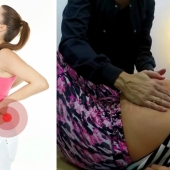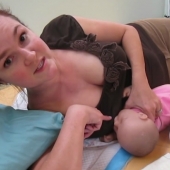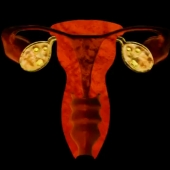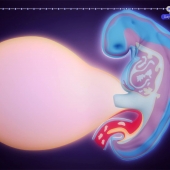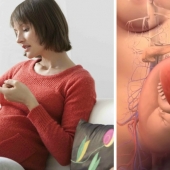This video performs you the process of a fertilized egg to a baby in 3D!! Excerpt from French documentary L'Odyssée de la Vie. After sexual intercourse, sperm travels through the cervix and uterus and into the Fallopian tubes. Conception usually takes place in the outer third of the Fallopian tube. A single sperm penetrates that egg and a joining of the genetic information occurs. This resulting single cell is called a zygote.
The zygote spends the next few days traveling down the Fallopian tube and rapidly multiplying the number of cells through division. A mulberry-like mass, like a hollow rubber ball, 1/100 inch wide, results from the cell division. This ball of cells in the Fallopian tube is called a morula.The embryonic stage begins on the 15th day after conception and continues until about the 8th week, or until the embryo is 1.2 inches in length.
Week 3 we see the formation of the heart, the beginning development of the brain and spinal cord, and the beginning of the gastrointestinal tract.
Weeks 4 and 5 -1/4 inch long: Here we see the beginnings of the vertebra, the lower jaw, the larynx ("voice box"), and the rudiments of the ear and eye. The heart, which is still outside body, now beats at a regular rhythm. Although arm and leg "buds" are visible with hand and foot "pads," the embryo still has a tail and cannot be distinguished from pig, rabbit, elephant, or chick embryo by an untrained eye.
Week 6 - 1/2 inch, 1/1000 of an ounce: In week 6, we see the formation of the nose, jaw, palate, lung buds. The fingers and toes form, but may still be webbed. The tail is receding, and the heart is almost fully developed.
Week 7 - 7/8 inch, 1/30 ounce (less than an aspirin): This week, the eyes move forward on the face, and the eyelids and tongue begin to form. All essential organs have begun to form.
Week 8 -1 inch, 1/15 ounce: The embryo now resembles a human being. The facial features continue to develop and the external ear appears. Also, we see the beginnings of external genitalia. By now, the circulation through the umbilical cord is well developed. The long bones begin to form and the muscles are able to contract. At this point the embryo is developed enough to call a fetus. All organs and structures found in a full-term newborn are present.
Weeks 9 to 12 - 3 inches, 1 ounce: The head comprises nearly half of the fetus' size and the face is well formed. The eyelids close now and will not reopen until about the 28th week. The tooth buds for the baby teeth appear. The genitalia are now clearly male or female.
Weeks 13 to 16 - 6 inches: These weeks mark the beginning of the second trimester. Although the skin of the fetus is almost transparent, fine hair develops on the head called lanugo. The fetus makes active movements, including sucking, which leads to some swallowing of the amniotic fluid. A thin dark substance called meconium is made in the intestinal tract. The heart beats120-150 beats per minute and brain waves detectable.
Weeks 17 to 20 - 8 inches: Eyebrows and lashes appear and nails appear on fingers and toes. This is an exciting time for the parents: The mother can feel the fetus moving ("quickening") and the fetal heartbeat can be heard with a stethoscope.
Weeks 21 to 24 - 11.2 inches, 1 lb. 10 oz.: All the eye components are developed, footprints and fingerprints are forming, and the entire body covered in cream-cheese-like vernix caseosa. The fetus now has a startle reflex.
Weeks 25 to 28 - 15 inches, 2 lbs. 11 oz.: Now we are entering the third trimester. During these weeks, we see rapid brain development. The nervous system is developed enough to control some body functions, and the eyelids open and close. A baby born at this time may survive, but the chances of complications and death are high.
Weeks 29 to 32 - 15 to 17 inches, 4 lbs. 6 oz.: These weeks see further development towards independent life: There is a rapid increase in the amount of body fat and the fetus begins storing its own iron, calcium, and phosphorus. The bones are fully developed, but still soft and pliable. There are rhythmic breathing movements present, the fetal body temperature is partially self-controlled, and there is increased central nervous system control over body functions.
Weeks 33 to 36 - 16 to 19 inches, 5 lbs. 12 oz. to 6 lbs. 12 oz.: The lanugo (body hair) begins to disappear. A baby born at 36 weeks has a high chance of survival.
Weeks 37 to 40 - 19 to 21 inches 7 or 8 pounds: At 38 weeks, the fetus is considered full term.
- 5856 views

